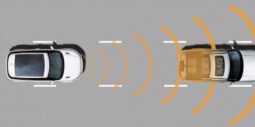
Adaptive cruise control what is it
Content
The adaptive cruise control (ACC) system has been used in modern cars for more than a year. However, not every motorist is able to clearly tell about its purpose. Meanwhile, it gives a lot of advantages.
Difference between adaptive and standard cruise control
The purpose of the cruise control system is to maintain the vehicle speed at a constant level with an automatic increase in throttle when a given speed decreases, and a decrease in it when a given speed increases (the latter can be observed, for example, during descents). Over time, the system continued to evolve towards increasing machine control automation.

The adaptive cruise control system is an improved version of it, which allows, simultaneously with maintaining the speed, to automatically reduce it if there is a hypothetical danger of colliding with the car in front. That is, there is an adaptation to road conditions.
System components and operating principle
The adaptive cruise control has three components:
- Distance sensors that measure the speed of the vehicle in front and the distance to it. They are located in bumpers and radiator grilles and are of two types:
- radars emitting ultrasonic and electromagnetic waves. The speed of the vehicle in front is determined by these sensors by the changing frequency of the reflected wave, and the distance to it is determined by the return time of the signal;
- lidars that send infrared radiation. They work in the same way as radars and are much cheaper, but less accurate, since they are susceptible to the weather.
The standard range of distance sensors is 150 m. However, ACCs have already appeared, whose sensors can work in a short range, changing the speed of the car until it stops completely, and in a long range, reducing the speed to 30 km / h.

This is very important if the car is in a traffic jam and can only move at low speed;
- A control unit with a special software package that receives information from sensor sensors and other automotive systems. Then it is compared with the parameters that were set by the driver. Based on these data, the distance to the vehicle in front is calculated, as well as its speed and the speed at which the vehicle with ACC is moving in it. They are also needed to calculate the steering angle, curve radius, lateral acceleration. The information obtained serves as the basis for creating a control signal, which the control unit sends to the executive equipment;
- Executive equipment. In general, ACC does not have executive equipment as such, but it sends a signal to systems associated with the control module: exchange rate stability system, electronic throttle drive, automatic transmission, brakes, etc.
Advantages and disadvantages of ACC
Like any part of a car, the adaptive cruise control system has its own set of advantages and disadvantages. Its advantages are:
- in fuel economy, since automatic control of distance and speed allows you not to press the brake again;
- in the ability to avoid a lot of accidents, since the system responds to emergency situations instantly;
- in relieving the driver of unnecessary load, since the need to constantly monitor the speed of his car for him disappears.
Disadvantages lie:
- in the technical factor. Any system is not insured against failures and breakdowns. In the case of ACC, contacts may oxidize, sensor sensors may malfunction, especially lidars in rain or snow, or ACC will not have time to respond in a timely manner if the car in front suddenly and sharply slows down. As a result, ACC at best will sharply accelerate the car or reduce its speed, so there is no need to talk about a comfortable ride, at worst it will lead to an accident;
- in the psychological factor. ACC almost completely automates the operation of the vehicle. As a result, its owner gets used to it and relaxes, forgetting to monitor the situation on the road and not having time to react if it turns into an emergency.
How adaptive cruise control works
The ACC is operated in the same way as a normal cruise control. The control panel is most often located on the steering wheel.

- Switching on and off is carried out using the On and Off buttons. Where these buttons are not available, simply press Set to turn on, and turn off by pressing the brake or clutch pedal. In any case, when turned on, the car owner does not feel anything, and you can turn off the ACC without problems even when it is working.
- Set and Accel help to set. In the first case, the driver pre-accelerates to the desired value, in the second - reduces the speed. The result is fixed by pressing the corresponding button. Each time you press it again, the speed will increase by 1 km / h.
- If, after braking, they want to return to the previous speed, they press the speed reduction and brake pedal, and then Resume. Instead of the brake pedal, you can use the Coact button, which, when pressed, will have the same effect.
Video: demonstration of adaptive cruise control
Questions and answers:
How is adaptive cruise control different from conventional cruise control? The key difference between these systems is the ability to automatically adjust to the quality of the road. Adaptive cruise also maintains the distance to the vehicle in front.
How does adaptive cruise work? It is an electronic system that controls the engine speed based on wheel speed and presets. She is also able to slow down on bad roads and if there is an obstacle ahead.
What is adaptive cruise control for? Compared to classic cruise control, the adaptive system has more options. This system provides safety if the driver is distracted from driving.
What is the function of the adaptive cruise control? When the road is empty, the system maintains the speed set by the driver, and when a car appears in front of the car, the cruise will reduce the speed of the car.
